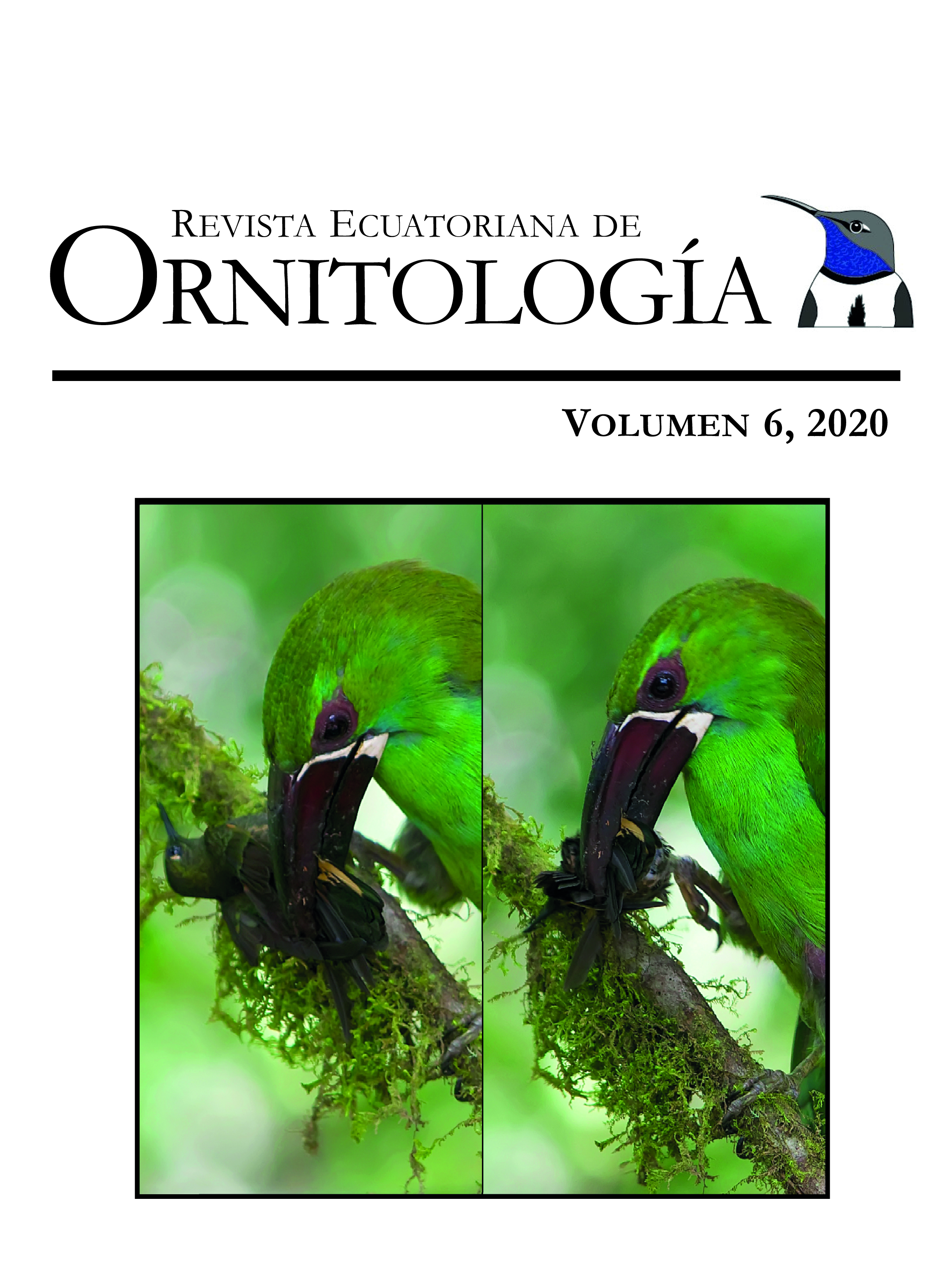OBSERVACIONES SOBRE LA FIDELIDAD DE TERRITORIO Y EXPECTATIVA DE VIDA DEL AZULITO ALTOANDINO Xenodacnis parina (THRAUPIDAE)
DOI:
https://doi.org/10.18272/reo.vi6.1348Palabras clave:
Amenazas, Andes, anillamiento, comportamiento, fidelidad, longevidad, territoriosResumen
Se conoce poco sobre la expectativa de vida de las aves andinas. El Azulito Altoandino Xenodacnis parina, distribuido en Ecuador y Perú, es un ave especialista de los Andes que se encuentra en parches de Polylepis caracterizados por la presencia de arbustos del género Gynoxys. Se anillaron varios individuos de X. parina en el Parque Nacional Cajas, en 2010, con anillos de colores. Tres individuos fueron registrados en la misma localidad 7 años después de haber sido anillados. Este trabajo brinda la primera información de fidelidad de territorio, comportamiento social y longevidad de esta especie, y brevemente evalúa la mortalidad causada por atropellamientos. Estos datos pueden apoyar acciones de conservación para X. parina.
Descargas
Citas
Aguilar, J.M., & Iñiguez, X. (2015). Hábitos alimentarios de Xenodacnis (Xenodacnis parina) en los páramos del sur del Ecuador. Ornitología Neotropical, 26, 211-217. URL: http://journals.sfu.ca/ornneo/index.php/ornneo/article/view/29
Aguilar, J.M. (2015). Description and Conservation status of a new subspecies of Xenodacnis parina (Aves: Thraupidae) from the Ecuadorian Andes (Tesis de Maestría en Biología de la Conservación). Pontificia Universidad Católica del Ecuador, Quito. URL: http://repositorio.puce.edu.ec/handle/22000/10378
Armstrong, D. P. (1995). Effects of familiarity on the outcome of translocations, II. A test using New Zealand Robins. Biological Conservation, 71, 281-288. DOI: https://doi.org/10.1016/0006-3207(94)00038-R
Beletsky, L. D., & Orians G. H. (1989). Familiar neighbors enhance breeding success in birds. Proceedings of the National Academy of Sciences, 86, 7933-7936.URL: https://www.ncbi.nlm.nih.gov/pmc/articles/PMC298186/pdf/pnas00287-0281.pdf
Bornschein, M. R., Pizo, M., Sobotka, D. D., Belmonte-Lopes, R., Golec, C., Machado-de-Souza, T., Pie, M. R., & Reinert, B. L. (2015). Longevity records and signs of aging in Marsh Antwren Formicivora acutirostris (Thamnophilidae). The Wilson Journal of Ornithology, 127(1), 98-102. DOI: https://doi.org/10.1676/14-074.1
Donald, P. F., Collar, N. J., Marsden, S. J., & Pain, D. J. (2010). Facing extinction: the world's rarest birds and the race to save them. Bloomsbury Publishing, Poyser, London, UK.
Finch, C. E. (1998). Variations in senescence and longevity include the possibility of negligible senescence. The Journals of Gerontology Series A: Biological Sciences and Medical Sciences, 53(4), B235-B239. DOI: https://doi.org/10.1093/gerona/53A.4.B235
Fjeldså, J. (1993). The avifauna of the Polylepis woodlands of the Andean highlands: the efficiency of basing conservation priorities on patterns of endemism. Bird Conservation International, 3, 37-55. DOI: https://doi.org/10.1017/S0959270900000770
Fjeldså, J. (1992). Biogeography of the birds of the Polylepis woodlands of the Andes. En Balslev, H., & Luteyn, J.L. (eds.), Paramo: An Andean ecosystem under human influence. Academic Press, London, UK (pp. 31).
Freile, J. F., & Santander, T. (2005). Áreas importantes para la conservación de las aves en Ecuador. En BirdLife International and Conservation International (eds.), Áreas importantes para la conservación de las aves en los Andes Tropicales: sitios prioritarios para la conservación de la biodiversidad. BirdLife International, Quito, Ecuador (pp. 283-470).
Lentino, M, Bonaccorso, E., García, M. A., Fernández, E. A., Rivero, R., & Portas, C. (2003). Longevity records of wild birds in the Henri Pittier National Park, Venezuela. Ornitología Neotropical, 14, 545-548. URL: https://sora.unm.edu/sites/default/files/journals/on/v014n04/p0545-p0548.pdf
Londoño, G. A , Chappell, M. A., Castañeda, M. D. R., Jankowski J. E., & Robinson, S. K. (2015). Basal metabolism in tropical birds: latitude, altitude, and the "˜pace of life"™. Functional Ecology, 29(3), 338-346.DOI: https://doi.org/10.1111/1365-2435.12348
Myers, N., Mittermeier, R. A., Mittermeier, C. G., da Fonseca G. A. B., & Kent, J. (2000). Biodiversity hotspots for conservation priorities. Nature, 403, 853-858. DOI: https://doi.org/10.1038/35002501
O'Neill, J. P., & Parker III, T. A. (1978). Responses of birds to a snowstorm in the Andes of southern Peru. Wilson Bulletin, 90(3), 446-449. URL: https://sora.unm.edu/sites/default/files/journals/wilson/v090n03/p0446-p0449.pdf
Paris, D., Nicholls, A. O., Hall, A., Harvey, A.,& Massaro, M. (2016). Female-biased dispersal in a spatially restricted endemic island bird. Behavioral Ecology and Sociobiology, 70(12), 2061-2069. DOI: 10.1007/s00265-016-2210-3
Vuilleumier, F. (1984). Patchy distribution and systematics of Oreomanes fraseri (Aves Coerebidae) of Andean Polylepis woodlands. American Museum Novitates, 2777, 1-17. URL: http://hdl.handle.net/2246/5260
Wasser, E., & Sherman, W. (2010). Avian longevities and their interpretation under evolutionary theories of senescence. Journal of Zoology, 280, 103-155. DOI: https://doi.org/10.1111/j.1469-7998.2009.00671.x
Descargas
Publicado
Cómo citar
Número
Sección
Licencia
Los autores que publiquen en la Revista Ecuatoriana de Ornitología aceptan los siguientes términos:
- Los autores/as conservarán sus derechos de autor y garantizarán a la revista el derecho de primera publicación de su obra, el cuál estará simultáneamente sujeto a la Licencia de Reconocimiento No Comercial de Creative Commons.
- Los autores/as podrán adoptar otros acuerdos de licencia no exclusiva de distribución de la versión de la obra publicada, pudiendo de esa forma publicarla en un volumen monográfico o reproducirla de otras formas, siempre que se indique la publicación inicial en esta revista.
- Se permite y se recomienda a los autores difundir su obra a través de Internet en su repositorio institucional, página web personal, o red social científica (como ResearchGate o Academia.edu).



